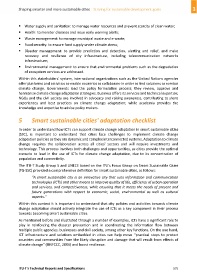Page 585 - Shaping smarter and more sustainable cities - Striving for sustainable development goals
P. 585
Water supply and sanitation: to manage water resources and prevent scarcity of clean water;
Health: to monitor diseases and issue early warning alerts;
Waste management: to manage municipal waste and e‐waste;
Food security: to ensure food supply under climate stress;
Disaster management: to provide prediction and detection, alerting and relief, and make
recovery and resilience of city infrastructure, including telecommunication networks
infrastructure;
Environmental management: to ensure that environmental problems such as the degradation
of ecosystem services are addressed.
Within this stakeholders' system, international organizations such as the United Nations agencies
offer platforms and activities to enable countries to collaborate in order to find solutions to combat
climate change. Governments lead the policy formulation process; they review, approve and
harmonize climate change adaptation strategies. Business offers its services and technical expertise;
NGOs and the civil society are involved in advocacy and raising awareness, contributing to share
experiences and best practices on climate change adaptation; while academia provides the
knowledge and expertise to advise policy makers.
5 Smart sustainable cities' adaptation checklist
In order to understand how ICTs can support climate change adaptation in smart sustainable cities
(SSC), is important to understand that cities face challenges to implement climate change
adaptation policies as they are dynamic and complex interconnected systems. Adaptation to climate
change requires the collaboration across all cities' sectors and will require investments and
technology. This process involves both challenges and opportunities, as cities provide the optimal
scenario to lead in the use of ICTs for climate change adaptation, due to its concentration of
population and connectivity.
The ITU‐T Study Group 5 and UNECE based on the ITU’s Focus Group on Smart Sustainable Cities
(FG‐SSC) provided a comprehensive definition for smart sustainable cities, as follows:
"A smart sustainable city is an innovative city that uses information and communication
technologies (ICTs) and other means to improve quality of life, efficiency of urban operation
and services, and competitiveness, while ensuring that it meets the needs of present and
future generations with respect to economic, social, environmental as well as cultural
aspects."
Within this context it is important to understand that city policies and activities towards climate
change adaptation should actively integrate the use of ICTs as a key component in their process
towards becoming smart sustainable cities.
As mentioned before and illustrated through a number of examples, ICTs have a significant role to
play in reinforcing the disaster prevention and in coordinating the information flow between
multiple public agencies, businesses and civil society, among other key functions. On the one hand,
ICT infrastructure and solutions embedded in cities can help move "practical steps to protect
countries and communities from the likely disruption and damage that will result from effects of
climate change" (UNFCCC, 2006) and boost resilience.
ITU‐T's Technical Reports and Specifications 575

